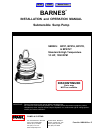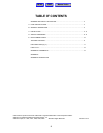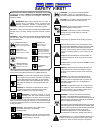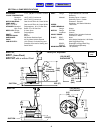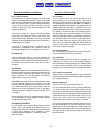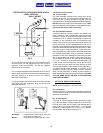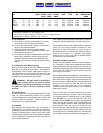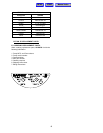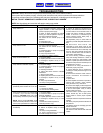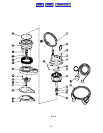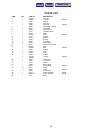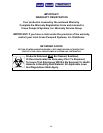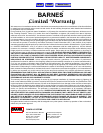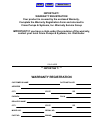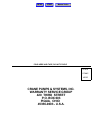
TROUBLESHOOTING
CAUTION ! Always disconnect the pump from the electrical power source before handling.
If the system fails to operate properly, carefully read instructions and perform maintenance recommendations.
If operating problems persist, the following chart may be of assistance in identifying and correcting them:
MATCH "CAUSE" NUMBER WITH CORRELATING "CORRECTION" NUMBER.
NOTE: Not all problems and correction will apply to each pump model.
PROBLEM CAUSE CORRECTION
Pump will not run. 1. Poor electrical connection, blown fuse,
tripped breaker or other interruption of
power; improper power supply.
2. Motor or switch inoperative (to isolate
cause, go to manual operation of pump).
2a. Float movement restricted.
2b. Switch will not activate pump or is
defective.
2c. Defective motor.
3. Insufficient liquid level.
1. Check all electrical connections for
security. Have electrician measure current
in motor leads, if current is within ±20% of
locked rotor Amps, impeller is probably
locked. If current is 0, overload may be
tripped. Remove power, allow pump to
cool, then recheck current.
2a. Reposition pump or clean basin as
required to provide adequate clearance for
float.
2b. Disconnect level control. Set
ohmmeter for a low range, such as 100
ohms full scale and connect to level control
leads. Actuate level control manually and
check to see that ohmmeter shows zero
ohms for closed switch and full scale for
open switch. (Float Switch).
2c. Check winding insulation (Megger
Test) and winding resistance. If check is
out side of range, dry and recheck. If still
defective, replace per service instructions.
3. Make sure liquid level is at least equal to
suggested turn-on point.
4. Recheck all sizing calculations to
determine proper pump size.
5. Check discharge line for restrictions,
including ice if line passes through or into
cold areas.
6. Remove and examine check valve for
proper installation and freedom of
operation.
7. Open valve.
8. Check impeller for freedom of operation,
security and condition. Clean impeller
cavity and inlet of any obstruction.
9. Loosen union slightly to allow trapped air
to escape.Verify that turn-off level of switch
is set so that impeller cavity is always
flooded. Clean vent hole.
10. Check rotation. If power supply is three
phase, reverse any two of three power
supply leads to ensure proper impeller
rotation.
11. Repair fixtures as required to eliminate
leakage.
12. Check pump temperature limits & fluid
temperature.
13. Replace portion of discharge pipe with
flexible connector.
14. Turn to automatic position.
15. Check for leaks around basin inlet and
outlets.
Pump will not turn off. 2a. Float movement restricted.
2b. Switch will not activate pump or is
defective.
4. Excessive inflow or pump not properly
sized for application.
9. Pump may be airlocked.
14. Switch is in "HAND" position.
Pump hums but doesn’t run. 1. Incorrect voltage.
8. Impeller jammed or loose on shaft, worn
or damaged, impeller cavity or inlet
plugged.
Pump delivers insufficient capacity. 1. Incorrect voltage.
4. Excessive inflow or pump not properly
sized for application.
5. Discharge restricted.
6. Check valve stuck closed or installed
backwards.
7. Shut-off valve closed.
8. Impeller jammed or loose on shaft, worn
or damaged, impeller cavity or inlet
plugged.
9. Pump may be airlocked.
10. Pump running backwards.
Pump cycles too frequently or runs
periodically when fixtures are not in use.
6. Check valve stuck closed or installed
backwards.
11. Fixtures are leaking.
15. Ground water entering basin.
Pump shuts off and turns on independent
of switch. (trips thermal overload
protector). CAUTION! Pump may start
unexpectedly. Disconnect power supply.
NOTE: Some pumps DO NOT have
thermal overload protection on the motor.
Check pump specifications to determine.
1. Incorrect voltage.
4. Excessive inflow or pump not properly
sized for application.
8. Impeller jammed, loose on shaft, worn
or damaged, impeller cavity or inlet
plugged.
12. Excessive water temperature
(internal protection only).
Pump operates noisily or vibrates
excessively.
2c. Worn bearings, motor shaft bent.
8. Debris in impeller cavity or broken
impeller.
10. Pump running backwards.
13. Piping attachments to building
structure too rigid or too loose.
9
Manual Index
HOME
MENU



